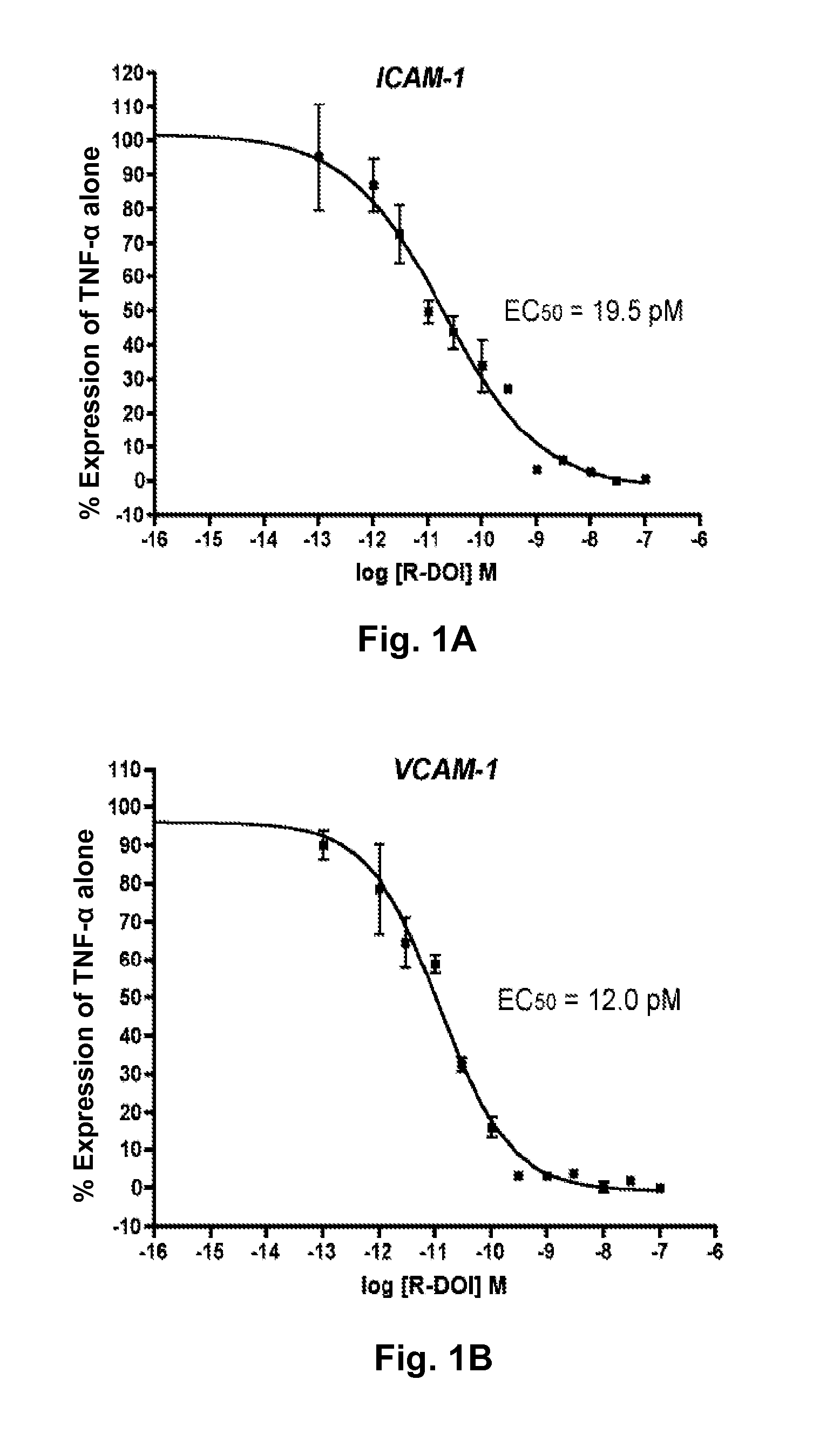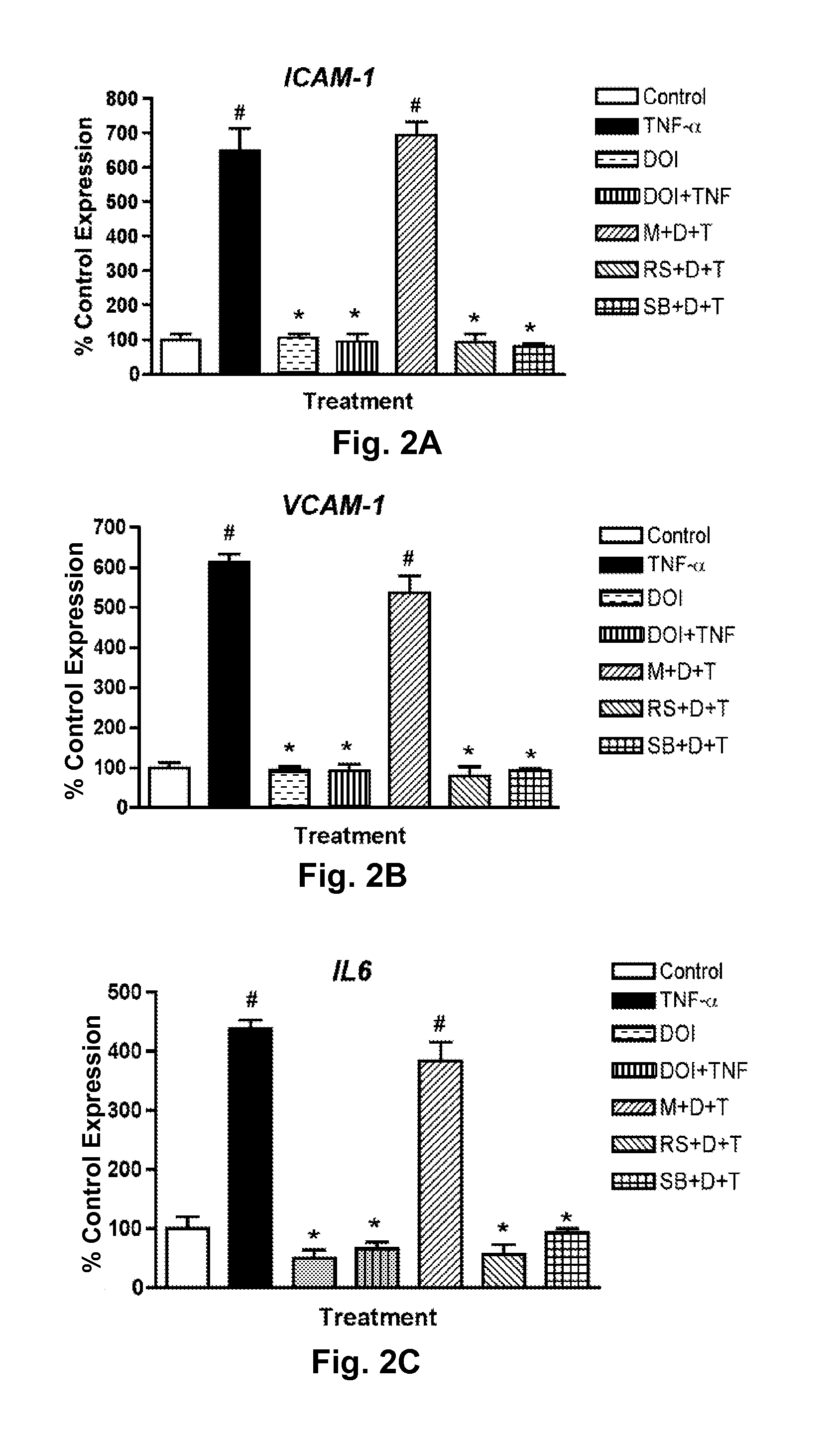Low Dosage Serotonin 5-HT2A Receptor Agonist To Suppress Inflammation
a serotonin receptor and low dosage technology, applied in the direction of biocide, drug composition, metabolic disorder, etc., can solve the problems of unclear 5-htsub>2a /sub>receptors in inflammatory processes, and achieve the effect of inhibiting the effect of tnf-, preventing inflammation, and inhibiting tnf--induced inflammation
- Summary
- Abstract
- Description
- Claims
- Application Information
AI Technical Summary
Benefits of technology
Problems solved by technology
Method used
Image
Examples
example 2
(R)-DOI Super-Potently Inhibits TNF-α Induced Expression of Proinflammatory Genes
[0044]Primary rat aortic smooth muscle (RASM) cells were verified to express 5-HT2A mRNA by QRT-PCR using primer sequences and probe as described in the methods section of Example 1 (data not shown). To examine the effects of 5-HT2A receptor activation on TNF-α mediated proinflammatory gene expression, RASM cells were pretreated with (R)-DOI, a selective 5-HT2 receptor agonist, as described above. Dose-response curves were determined for the effects on ICAM-1, VCAM-1, and IL-6 gene expression for twelve different concentrations of (R)-DOI ranging from 0.1 pM to 100 nM, with each experiment repeated in triplicate. The results are shown in FIGS. 1A, 1B, and 1C. In FIGS. 1A-1C, the Y-axis represents a percent of TNF-α for the dose of (R)-DOI indicated on the X-axis. The IC50 for proinflammatory gene expression inhibition is between 10-20 pM for all three (ICAM-1=19.5 pM; VCAM-1=12.0 pM; IL-6=10.3 pM). This...
example 3
Inhibition of Proinflammatory Markers Mediated Through 5-HT2A Receptor Activation
[0048]Because (R)-DOI is an agonist at all three 5-HT2 receptor isoforms, receptor selective antagonists were selected to determine which receptor was mediating the (R)-DOI effect. RASM cells were treated with a control solution (Control), TNF-α alone (TNF-α), (R)-DOI alone (DOI), pretreatment with (R)-DOI (1 nM) prior to TNF-α (DOI+TNF), pretreatment with the 5-HT2A receptor selective antagonist M100907 (100 nM) 30 minutes prior to (R)-DOI and TNF-α (M+D+T), pretreatment with 100 nM of the 5-HT2B receptor selective antagonist SB204741 prior to (R)-DOI and TNF-α (S+D+T), and pretreatment with 100 nM of the 5-HT2B receptor selective antagonist SB204741 prior to (R)-DOI and TNF-α (S+D+T).
[0049]The results are shown in FIGS. 2A, 2B, and 2C for the induced expression of ICAM-1, VCAM-1, and IL-6, respectively. TNF-α treatment alone (10 ng / ml) (TNF-α) induced expression of ICAM-1, VCAM-1, and IL-6. (R)-DOI at...
example 4
Additional 5-HT2A Receptor Agonists Inhibit Proinflammatory Marker Expression
[0051]To examine if these effects were exclusive for (R)-DOI acting at 5-HT2A receptors, other 5-HT2A agonists were tested for ability to inhibit proinflammatory marker expression. These included an additional phenethylamine, 4-Bromo-3,6-dimethoxybenzocyclobuten-1-yl) methylamine (2C-BCB), and two indolealkylamines, (2′S,4′S)-(+)-9,10-Didehydro-6-methylergoline-8β-(trans-2,4-dimethylazetidide) (LA-SS-Az) and lysergic acid diethylamide (LSD). All three have high affinity for rat 5-HT2A receptors (Ki of 2C-BCB=0.73 nM; LA-SS-Az=8.3 nM; LSD=3.5 nM) as well as high potency for activating PI turnover (EC50 of 2C-BCB=36 nM; LA-SS-Az=19 nM; LSD=15 nM) (Nichols et al., 2002; McLean et al., 2006).
[0052]The phenethylamine 2C-BCB, and the indolealkylamines LA-SS-Az and LSD, were tested for their ability to block TNF-α-mediated increases in proinflammatory gene expression at both 1 nM and 50 nM concentrations. The resu...
PUM
| Property | Measurement | Unit |
|---|---|---|
| concentrations | aaaaa | aaaaa |
| time course analysis | aaaaa | aaaaa |
| time course analysis | aaaaa | aaaaa |
Abstract
Description
Claims
Application Information
 Login to View More
Login to View More - R&D
- Intellectual Property
- Life Sciences
- Materials
- Tech Scout
- Unparalleled Data Quality
- Higher Quality Content
- 60% Fewer Hallucinations
Browse by: Latest US Patents, China's latest patents, Technical Efficacy Thesaurus, Application Domain, Technology Topic, Popular Technical Reports.
© 2025 PatSnap. All rights reserved.Legal|Privacy policy|Modern Slavery Act Transparency Statement|Sitemap|About US| Contact US: help@patsnap.com



